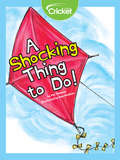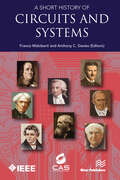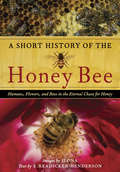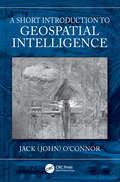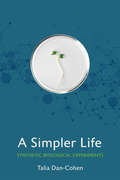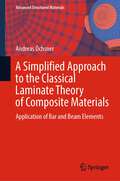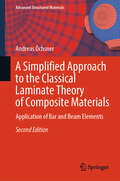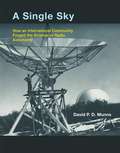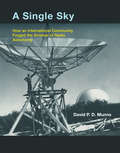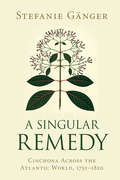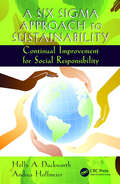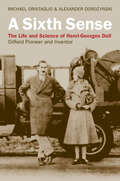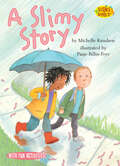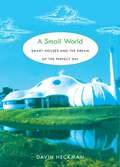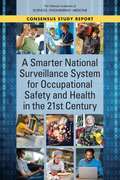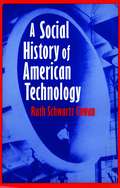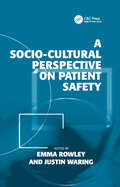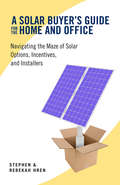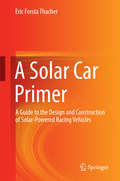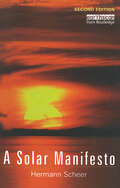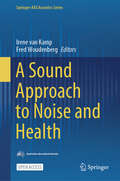- Table View
- List View
A Shock to the System: Restructuring America's Electricity Industry
by Dallas Burtraw Timothy J. Brennan Alan J. Krupnick Karen L. Palmer Raymond J. Kopp Vito StaglianoA Shock to the System is a guide to the decisions that will be faced by electricity providers, customers, and policymakers. Produced by a team of analysts at Resources for the Future, this concise and balanced work provides background necessary to understand the increasing role of competition in electricity markets. The authors introduce important concepts and terminology, and offer the history of public policy regarding electricity. They identify the significant proposals for implementing competition, and examine the potential consequences for regulation, industry structure, cost recovery, and the environment.
A Shock-Fitting Primer (Chapman & Hall/CRC Applied Mathematics & Nonlinear Science)
by Manuel D. SalasA defining feature of nonlinear hyperbolic equations is the occurrence of shock waves. While the popular shock-capturing methods are easy to implement, shock-fitting techniques provide the most accurate results. A Shock-Fitting Primer presents the proper numerical treatment of shock waves and other discontinuities. The book begins by recounting the events that lead to our understanding of the theory of shock waves and the early developments related to their computation. After presenting the main shock-fitting ideas in the context of a simple scalar equation, the author applies Colombeau’s theory of generalized functions to the Euler equations to demonstrate how the theory recovers well-known results and to provide an in-depth understanding of the nature of jump conditions. He then extends the shock-fitting concepts previously discussed to the one-dimensional and quasi-one-dimensional Euler equations as well as two-dimensional flows. The final chapter explores existing and future developments in shock-fitting methods within the framework of unstructured grid methods.Throughout the text, the techniques developed are illustrated with numerous examples of varying complexity. On the accompanying downloadable resources, MATLAB® codes serve as concrete examples of how to implement the ideas discussed in the book.
A Shocking Thing to Do!
by Pat ThomasOne thing everybody said about Benjamin Franklin was that you never knew what he might do next.
A Short History of Circuits and Systems (River Publishers Rapids Series in Electronic Materials, Circuits and Devices)
by Franco Maloberti Anthony C. Davies Myung Hoon Sunwoo Yongfu Li Fidel Makatia Hanho Lee Fakhrul Zaman RokhaniAfter an overview of major scientific discoveries of the 18th and 19th centuries, which created electrical science as we know and understand it and led to its useful applications in energy conversion, transmission, manufacturing industry and communications, this Circuits and Systems History book fills a gap in published literature by providing a record of the many outstanding scientists, mathematicians and engineers who laid the foundations of Circuit Theory and Filter Design from the mid-20th Century. Additionally, the book records the history of the IEEE Circuits and Systems Society from its origins as the small Circuit Theory Group of the Institute of Radio Engineers (IRE), which merged with the American Institute of Electrical Engineers (AIEE) to form IEEE in 1963, to the large and broad-coverage worldwide IEEE Society which it is today.This second edition, commemorating the 75th anniversary of the Circuits and Systems Society, builds upon the first edition's success by expanding the scope of specific chapters, introducing new topics of relevance, and integrating feedback from readers and experts in the field, reflecting the evolving landscape of Circuits and Systems alongside the evolution of the professional society.Many authors from many countries contributed to the creation of this book, working to a very tight time schedule. The result is a substantial contribution to their enthusiasm and expertise, which it is hoped readers will find both interesting and useful. It is certain that in such a book, omission will be found, and in the space and time available, much valuable material had to be left out. It is hoped that this book will stimulate an interest in the marvelous heritage and contributions of the many outstanding people who worked in the Circuits and Systems area.
A Short History of Circuits and Systems (River Publishers Series In Circuits And Systems Ser.)
by Franco Maloberti Anthony C. DaviesAfter an overview of major scientific discoveries of the 18th and 19th centuries, which created electrical science as we know and understand it and led to its useful applications in energy conversion, transmission, manufacturing industry and communications, this Circuits and Systems History book fills a gap in published literature by providing a record of the many outstanding scientists, mathematicians and engineers who laid the foundations of Circuit Theory and Filter Design from the mid-20th Century. Additionally, the book records the history of the IEEE Circuits and Systems Society from its origins as the small Circuit Theory Group of the Institute of Radio Engineers (IRE), which merged with the American Institute of Electrical Engineers (AIEE) to form IEEE in 1963, to the large and broad-coverage worldwide IEEE Society which it is today.Many authors from many countries contributed to the creation of this book, working to a very tight time-schedule. The result is a substantial contribution to their enthusiasm and expertise which it is hoped that readers will find both interesting and useful. It is sure that in such a book omissions will be found and in the space and time available, much valuable material had to be left out. It is hoped that this book will stimulate an interest in the marvellous heritage and contributions that have come from the many outstanding people who worked in the Circuits and Systems area.
A Short History of the Honey Bee: Humans, Flowers, and Bees in the Eternal Chase for Honey
by E. Readicker-Henderson Ilona McCartyThere are around 16,000 species of bee. Only seven of these are responsible for creating the world's sweetest treat—honey. Combining Ilona's gorgeous photography and E. Readicker-Henderson's engaging text, A Short History of the Honey Bee follows the journey from flower to hive to honey throughout history.A Short History of the Honey Bee starts with the story of the honey bee—why it is named Apis mellifera, how it has evolved from a solitary creature to one that travels in groups, why it stings, and how pollination really works. Readicker-Henderson then moves on to the honey, detailing its history from a wild food foraged for on cliffs to the many varieties available for purchase today. But it is the everyday importance of the bee that remains the central message. Forty percent of the world's food supply—including apples, tomatoes, and strawberries—is dependent on pollination by honeybees. Colony collapse, when the worker bees suddenly disappear and leave behind the queen and the hive, is an ecological and agricultural crisis. For this reason alone we need to be more aware of the significance of bees.
A Short Introduction to Geospatial Intelligence
by Jack O'ConnorA Short Introduction to Geospatial Intelligence explains the newest form of intelligence used by governments, commercial organizations, and individuals. Geospatial intelligence combines late 20th century historically derived ways of thinking and early 21st century technologies of GIS, GPS, digital imaging satellites and communications satellites to identify, measure, and analyze the current risk in the world. These ways of thinking have developed from military engineering, cartography, photointerpretation, and imagery analysis. While the oldest example dates back to the early 16th century, all the ways of spatial thinking share the common thread of being developed and refined during conflicts to help military leaders make informed decisions prior to action. In the 21st century— thanks in great part to advances in digital precision technology, miniaturization, and the commercialization of satellites— these ways of thinking have expanded from the military into various other industries and sectors including energy, agriculture, environment, law enforcement, global risk assessment, and climate monitoring. Features: • Analyzes human and algorithmic models for dealing with the challenge of analytic attention, in an age of geospatial data overload • Establishes an original model— envisioning, discovery, recording, comprehending, and tracking— for the spatial thinking that underpins the practice and growth of this emerging discipline • Addresses the effects of small satellites on the collection and analysis of geospatial intelligence A Short Introduction to Geospatial Intelligence describes the development of the five steps in geospatial thinking— envisioning, discovery, recording, comprehending, and tracking— in addition to addressing the challenges, and future applications, of this newest intelligence discipline.
A Simpler Life: Synthetic Biological Experiments (Expertise: Cultures and Technologies of Knowledge)
by Talia Dan-CohenA Simpler Life approaches the developing field of synthetic biology by focusing on the experimental and institutional lives of practitioners in two labs at Princeton University. It highlights the distance between hyped technoscience and the more plodding and entrenched aspects of academic research. Talia Dan-Cohen follows practitioners as they wrestle with experiments, attempt to publish research findings, and navigate the ins and outs of academic careers. Dan-Cohen foregrounds the practices and rationalities of these pursuits that give both researchers' lives and synthetic life their distinctive contemporary forms. Rather than draw attention to avowed methodology, A Simpler Life investigates some of the more subtle and tectonic practices that bring knowledge, doubt, and technological intervention into new configurations. In so doing, the book sheds light on the more general conditions of contemporary academic technoscience.
A Simplified Approach to the Classical Laminate Theory of Composite Materials: Application of Bar and Beam Elements (Advanced Structured Materials #192)
by Andreas ÖchsnerThis book provides a systematic introduction to composite materials, which are obtained by a layer-wise stacking of one-dimensional bar/beam elements. Each layer may have different mechanical properties but each single layer is considered as isotropic. The major idea is to provide a simplified theory to easier understand the classical two-dimensional laminate theory for composites based on laminae with unidirectional fibers. In addition to the elastic behavior, failure is investigated based on the maximum stress, maximum strain, Tsai-Hill, and the Tsai-Wu criteria. Partial differential equations lay the foundation to mathematically describe the mechanical behavior of any classical structural member known in engineering mechanics, including composite materials. The so-called classical laminate theory provides a simplified stress analysis, and a subsequent failure analysis, without the solution of the system of coupled differential equations for the unknown displacements. The procedure provides the solution of a statically indeterminate system based on a generalized stress–strain relationship under consideration of the constitutive relationship and the definition of the so-called stress resultants. This laminate theory is typically provided for two-dimensional plane problems, where the basic structural element is a simple superposition of a classical plane elasticity element with a thin plate element under the consideration of an orthotropic constitutive law. This two-dimensional approach and the underlying advanced continuum mechanical modeling might be very challenging for some students, particularly at universities of applied sciences. Thus, a reduced approach, the so-called simplified classical laminate theory, has been developed. The idea is to use solely isotropic one-dimensional elements, i.e., a superposition of bar and beam elements, to introduce the major calculation steps of the classical laminate theory. Understanding this simplified theory is much easier and the final step it to highlight the differences when moving to the general two-dimensional case.
A Simplified Approach to the Classical Laminate Theory of Composite Materials: Application of Bar and Beam Elements (Advanced Structured Materials #242)
by Andreas ÖchsnerThis book provides a systematic introduction to composite materials, which are obtained by a layer-wise stacking of one-dimensional bar/beam elements. Each layer may have different mechanical properties, but each single layer is considered as isotropic. The major idea is to provide a simplified theory to easily understand the classical two-dimensional laminate theory for composites based on laminae with unidirectional fibers. In addition to the elastic behavior, failure is investigated based on the maximum stress, maximum strain, Tsai-Hill, and the Tsai-Wu criteria. Partial differential equations lay the foundation to mathematically describe the mechanical behavior of any classical structural member known in engineering mechanics, including composite materials. The so-called classical laminate theory provides a simplified stress analysis, and a subsequent failure analysis, without the solution of the system of coupled differential equations for the unknown displacements. The procedure provides the solution of a statically indeterminate system based on a generalized stress–strain relationship under consideration of the constitutive relationship and the definition of the so-called stress resultants. This laminate theory is typically provided for two-dimensional plane problems, where the basic structural element is a simple superposition of a classical plane elasticity element with a thin plate element under the consideration of an orthotropic constitutive law. This two-dimensional approach and the underlying advanced continuum mechanical modeling might be very challenging for some students, particularly at universities of applied sciences. Thus, a reduced approach, the so-called simplified classical laminate theory, has been developed. The idea is to use solely isotropic one-dimensional elements, i.e., a superposition of bar and beam elements, to introduce the major calculation steps of the classical laminate theory. Understanding this simplified theory is much easier and the final step it to highlight the differences when moving to the general two-dimensional case.
A Single Sky: How an International Community Forged the Science of Radio Astronomy
by David P. D. MunnsFor more than three thousand years, the science of astronomy depended on visible light. In just the last sixty years, radio technology has fundamentally altered how astronomers see the universe. Combining the wartime innovation of radar and the established standards of traditional optical telescopes, the "radio telescope" offered humanity a new vision of the universe. In A Single Sky, the historian David Munns explains how the idea of the radio telescope emerged from a new scientific community uniting the power of radio with the international aspirations of the discipline of astronomy. The radio astronomers challenged Cold War era rivalries by forging a united scientific community looking at a single sky.Munns tells the interconnecting stories of Australian, British, Dutch, and American radio astronomers, all seeking to learn how to see the universe by means of radio. Jointly, this international array of radio astronomers built a new "community" style of science opposing the "glamour" of nuclear physics. A Single Sky describes a communitarian style of science, a culture of interdisciplinary and international integration and cooperation, and counters the notion that recent science has been driven by competition. Collaboration, or what a prominent radio astronomer called "a blending of radio invention and astronomical insight," produced a science as revolutionary as Galileo's first observations with a telescope. Working together, the community of radio astronomers revealed the structure of the galaxy.
A Single Sky: How an International Community Forged the Science of Radio Astronomy (The\mit Press Ser.)
by David P.D. MunnsHow radio astronomers challenged national borders, disciplinary boundaries, and the constraints of vision to create an international scientific community.For more than three thousand years, the science of astronomy depended on visible light. In just the last sixty years, radio technology has fundamentally altered how astronomers see the universe. Combining the wartime innovation of radar and the established standards of traditional optical telescopes, the “radio telescope” offered humanity a new vision of the universe. In A Single Sky, the historian David Munns explains how the idea of the radio telescope emerged from a new scientific community uniting the power of radio with the international aspirations of the discipline of astronomy. The radio astronomers challenged Cold War era rivalries by forging a united scientific community looking at a single sky.Munns tells the interconnecting stories of Australian, British, Dutch, and American radio astronomers, all seeking to learn how to see the universe by means of radio. Jointly, this international array of radio astronomers built a new “community” style of science opposing the “glamour” of nuclear physics. A Single Sky describes a communitarian style of science, a culture of interdisciplinary and international integration and cooperation, and counters the notion that recent science has been driven by competition. Collaboration, or what a prominent radio astronomer called “a blending of radio invention and astronomical insight,” produced a science as revolutionary as Galileo's first observations with a telescope. Working together, the community of radio astronomers revealed the structure of the galaxy.
A Singular Remedy: Cinchona Across the Atlantic World, 1751–1820 (Science in History)
by Stefanie GängerStefanie Gänger explores how medical knowledge was shared across societies tied to the Atlantic World between 1751 and 1820. Centred on Peruvian bark or cinchona, Gänger shows how that remedy and knowledge about its consumption – formulae for bittersweet, 'aromatic' wines, narratives about its discovery or beliefs in its ability to prevent fevers – were understood by men and women in varied contexts. These included Peruvian academies and Scottish households, Louisiana plantations and Moroccan court pharmacies alike. This study in plant trade, therapeutic exchange, and epistemic brokerage shows how knowledge weaves itself into the fabric of everyday medical practice in different places.
A Six Sigma Approach to Sustainability: Continual Improvement for Social Responsibility (Systems Innovation Book Ser. #41)
by Holly A. DuckworthIn an age when most business plans extend only to the next quarterly reporting period, the authors of this book propose an audaciously longer view of future planning. Reaching beyond the modern five or ten-year strategic plan, the authors take a cue from Kongo Gumi, a Japanese construction company launched in 578 AD that managed to thrive as a fami
A Sixth Sense: The Life and Science of Henri-Georges Doll: Oilfield Pioneer and Inventor
by Michael Oristaglio Alexander DorozynskiThe true story of the French engineer and inventor who developed a mine detector for the US Army during WWII—and then went on to transform the oil industry. In March 1940, with Europe at war, French army lieutenant Henri-Georges Doll came to the U.S. embassy in Paris to give a deposition. Doll was an artillery commander, a graduate of France&’s grandes écoles of science, engineering, and service. He had been mobilized to the front at the start of the war, then quickly recalled to Paris to work on a secret device for detecting the deadly land mines being planted by the German army on a vast new scale. But Doll&’s deposition that day had nothing to do with the war. He had come to testify in a patent lawsuit pending in Houston, Texas. The case was Schlumberger Well Surveying Corporation v. Halliburton Oil Well Cementing Company: it marked one of the first great industrial battles for control of the technology of oil and gas exploration. When the German army marched into Paris three months later, Doll escaped to America, where he developed his new mine detector for the U.S. army, then settled in a small Connecticut town to become one of the most prolific inventors of the twentieth century. His sixth sense for applied science would help create the modern technology of seeing underground using electrical signals and sound waves—technology that would enable the explosive growth of oil production, and of Schlumberger, after the war. This biography tells his remarkable story.
A Slimy Story (Science Solves It!)
by Michelle KnudsenSlimy! Yucky! Wriggly! Dan is grossed out by earthworms until one of them hitches a ride in his pocket—and creates a sensation in school!
A Small World: Smart Houses and the Dream of the Perfect Day
by Davin HeckmanConceived in the 1960s, Walt Disney's original plans for his Experimental Prototype Community of Tomorrow (EPCOT) outlined a utopian laboratory for domestic technology, where families would live, work, and play in an integrated environment. Like many of his contemporaries, Disney imagined homes that would attend to their inhabitants' every need, and he regarded the home as a site of unending technological progress. This fixation on "space-age" technology, with its promise of domestic bliss, marked an important mid-twentieth-century shift in understandings of the American home. In A Small World, Davin Heckman considers how domestic technologies that free people to enjoy leisure time in the home have come to be understood as necessary parts of everyday life. Heckman's narrative stretches from the early-twentieth-century introduction into the home of electric appliances and industrial time-management techniques, through the postwar advent of television and the space-age "house of tomorrow," to the contemporary automated, networked "smart home. " He considers all these developments in relation to lifestyle and consumer narratives. Building on the tension between agency and control within the walls of homes designed to anticipate and fulfill desires, Heckman engages debates about lifestyle, posthumanism, and rights under the destabilizing influences of consumer technologies, and he considers the utopian and dystopian potential of new media forms. Heckman argues that the achievement of an environment completely attuned to its inhabitants' specific wants and needs--what he calls the "Perfect Day"--institutionalizes everyday life as the ultimate consumer practice.
A Smarter National Surveillance System for Occupational Safety and Health in the 21st Century
by Engineering Medicine National Academies of SciencesThe workplace is where 156 million working adults in the United States spend many waking hours, and it has a profound influence on health and well-being. Although some occupations and work-related activities are more hazardous than others and face higher rates of injuries, illness, disease, and fatalities, workers in all occupations face some form of work-related safety and health concerns. Understanding those risks to prevent injury, illness, or even fatal incidents is an important function of society. Occupational safety and health (OSH) surveillance provides the data and analyses needed to understand the relationships between work and injuries and illnesses in order to improve worker safety and health and prevent work-related injuries and illnesses. Information about the circumstances in which workers are injured or made ill on the job and how these patterns change over time is essential to develop effective prevention programs and target future research. The nation needs a robust OSH surveillance system to provide this critical information for informing policy development, guiding educational and regulatory activities, developing safer technologies, and enabling research and prevention strategies that serves and protects all workers. A Smarter National Surveillance System for Occupational Safety and Health in the 21st Century provides a comprehensive assessment of the state of OSH surveillance. This report is intended to be useful to federal and state agencies that have an interest in occupational safety and health, but may also be of interest broadly to employers, labor unions and other worker advocacy organizations, the workers’ compensation insurance industry, as well as state epidemiologists, academic researchers, and the broader public health community. The recommendations address the strengths and weaknesses of the envisioned system relative to the status quo and both short- and long-term actions and strategies needed to bring about a progressive evolution of the current system.
A Social History of American Technology
by Ruth Schwartz Cowan(back of book) For over 250 years American technology has been regarded as a unique hallmark of American culture and an important factor in American prosperity. Despite this, American history has rarely been told from the perspective of the history of technology. A Social History of American Technology fills this gap by surveying the history of American technology from the tools used by the earliest native inhabitants to the technological systems- cars and computers, aircraft and antibiotics- we are familiar with today. Cowan makes use of the most recent scholarship to explain how the unique characteristics of American cultures and American geography have affected the technologies that have been invented, manufactured, and used throughout the years. She also focuses on the key individuals and ideas that have shaped important technological developments. The text explains how various technologies have affected the ways in which Americans work, govern, cook, transport, communicate, maintain their health, and reproduce. Cowan demonstrates that technological change has always been closely related to social development, and explores the multiple, complex relationships that have existed between such diverse social agents as households and businesses, the scientific community and the defense establishment, artists and inventors. Divided into three sections- colonial America. industrialization, the 20th century- A Social History of American Technology is ideal for courses in American social and economic history, as a correlated text for the American history survey, as well as for courses that focus on the history of technology. It offers students the unique opportunity to learn not only how profoundly technological change has affected the American way of life, but how profoundly the American way of life has affected technology.
A Socio-cultural Perspective on Patient Safety
by Justin WaringThis edited volume of original chapters brings together researchers from around the world who are exploring the facets of health care organization and delivery that are sometimes marginal to mainstream patient safety theories and methodologies but offer important insights into the socio-cultural and organizational context of patient safety. By examining these critical insights or perspectives and drawing upon theories and methodologies often neglected by mainstream safety researchers, this collection shows we can learn more about not only the barriers and drivers to implementing patient safety programmes, but also about the more fundamental issues that shape notions of safety, alternate strategies for enhancing safety, and the wider implications of the safety agenda on the future of health care delivery. In so doing, A Socio-cultural Perspective on Patient Safety challenges the taken-for-granted assumptions around fundamental philosophical and political issues upon which mainstream orthodoxy relies. The book draws upon a range of theoretical and empirical approaches from across the social sciences to investigate and question the patient safety movement. Each chapter takes as its focus and question a particular aspect of the patient safety reforms, from its policy context and theoretical foundations to its practical application and manifestation in clinical practice, whilst also considering the wider implications for the organization and delivery of health care services. Accordingly, the chapters each draw upon a distinct theoretical or methodological approach to critically explore specific dimensions of the patient safety agenda. Taken as a whole, the collection advances a strong, coherent argument that is much needed to counter some of the uncritical assumptions that need to be described and analyzed if patient safety is indeed to be achieved.
A Solar Buyer's Guide for the Home and Office
by stephen Rebekah HrenSolar power, once a fringe effort limited to DIY enthusiasts, is now fast becoming mainstream. Many home and business owners are curious about solar electric and solar thermal systems, and wonder how to go about getting a clean energy generation system of their own. The vast majority will hire a professional installer to do the job. But what should they be asking of these installers? What system makes the most sense for their home or office: solar electric, solar hot water, solar heating, or some combination of these? A Solar Buyer's Guide for the Home and Officeexplains the options so that property owners can make the right choices both for their energy needs and their financial security. Understanding how solar power systems work will enable readers to be informed customers when dealing with professional installers-the book also provides advice on how to select a qualified installer and understand the expanding variety of tax credits and other incentives that are popping up around the country. The market for solar systems has been growing at an exponential rate and strong tax credits ensure continued growth even in a sluggish economy. Many of those who would like to catch this undeniable wave of the future are held back by widespread confusion. A Solar Buyer's Guide for the Home and Officeclears the air, allowing property owners to move forward with confidence to make their homes and offices more comfortable, environmentally sound, and secure against wild swings in energy prices.
A Solar Car Primer: A Guide to the Design and Construction of Solar-Powered Racing Vehicles
by Eric Forsta ThacherThis exciting primer on Solar Racing literally starts from the ground up, describing how the interactions of a vehicle with its environment circumscribe its ultimate success, from aerodynamics to resistance and propulsion. By demonstrating how to mathematically model these underlying physical phenomena, the author helps solar racing competitors carefully select key characteristics of the vehicle, such as weight and shape, to produce optimal speed. Energy conversion and demand are given particular attention, followed by chapters devoted to examining solar racers' design, manufacture and testing using a structured problem-solving process to keep projects on track and on schedule. A chapter devoted to energy management strategies provides invaluable tips on maximizing average speed during a race. Complex issues such as ventilation system analysis and performance simulation are covered in dedicated appendices. The financial aspect of project design is not neglected, as both fund-raising and cost estimation are given in-depth consideration.
A Solar Manifesto
by Hermann ScheerIn the decade since the 'Earth Summit' in Rio de Janiero, the response of the world's governments and authorities to the threats to the global environment has been to enforce the reduction of energy consumption and harmful emissions - solutions primarily based around conventional energy resources and conventional thinking. The question is, though, whether this strategy is radical enough to address the key challenges how facing the environment, and whether it can be effective in avoiding catastrophe on a global scale. For Herman Scheer, the answer is a definite no. In this fully updated edition of A Solar Manifesto, he once more attacks the lack of political will to find answers outside a conventional frame of reference. Climate change, pollution, deforestation, destruction of the ozone layer, poverty and the population explosion are all problems created or exacerbated by the use of conventional energy. Seven years after the first edition of this book, answers are now more urgently required that ever, as current policies serve merely to alleviate the escalating symptoms rather than attempting a cure for what could become a terminal affliction. Herman Scheer shows that this crisis may yet be reversed – but it can only be made to happen through a fundamental change in political and economic strategies, paving the way towards a global solar energy economy sustained by new social principles. A Solar Manifesto champions the replacement of fossil and nuclear fuels with solar energy, as a real solution to the threat to the environment and associated social consequences. Scheer constructs a radical yet innovative political and economic model and argues the case with passion and conviction for the global solar economy as the route to a sustainable environment. Thought-provoking and profoundly challenging, this book will be an inspiration to anyone concerned with energy and the global environment.
A Solar-Powered Planet (Into Reading, Level V #59)
by Bill Wood Jill McDougallNIMAC-sourced textbook.
A Sound Approach to Noise and Health (Springer-AAS Acoustics Series)
by Irene Van Kamp Fred WoudenbergThis open access book highlights the negative and positive health effects of chronic exposure to environmental sound. It describes the state of the art in the field from a public health point of view and puts it in a broad societal perspective looking at sound from physical, social, psychological, economic and governance angles. Rather than a mere collection of papers around the theme as usually provided in special issues, this book offers a comprehensive look at the meaning of sound in society and its impacts and provides directions to further advance the field.


